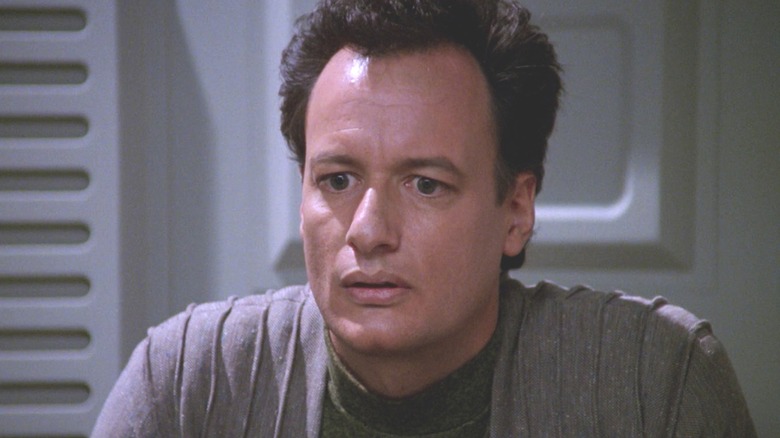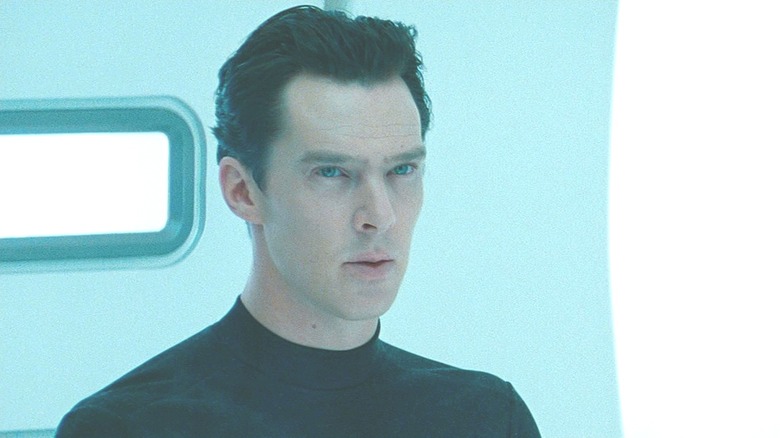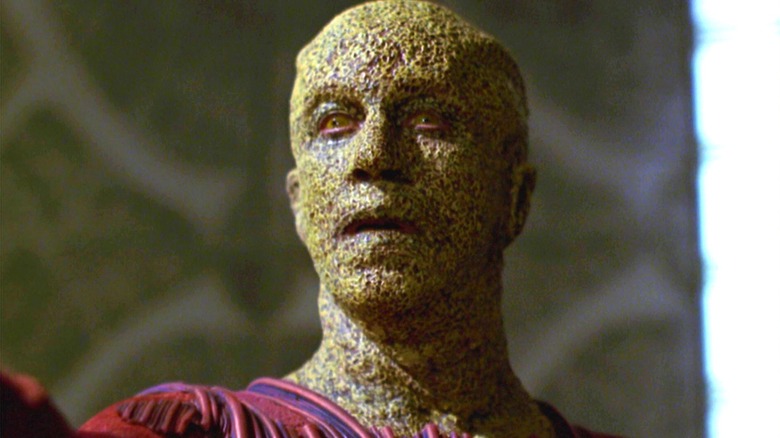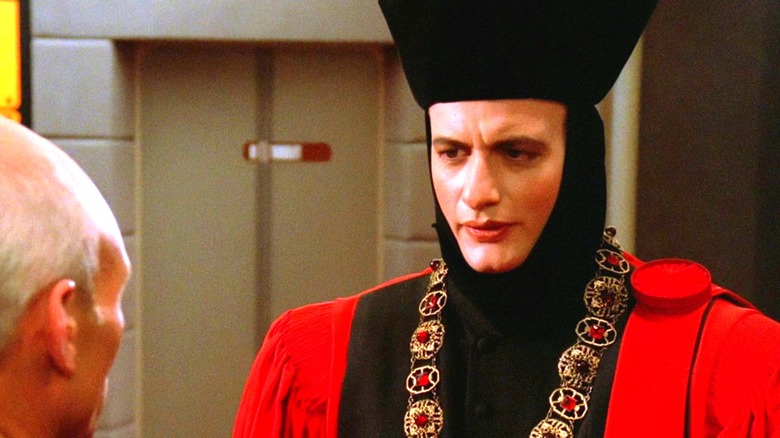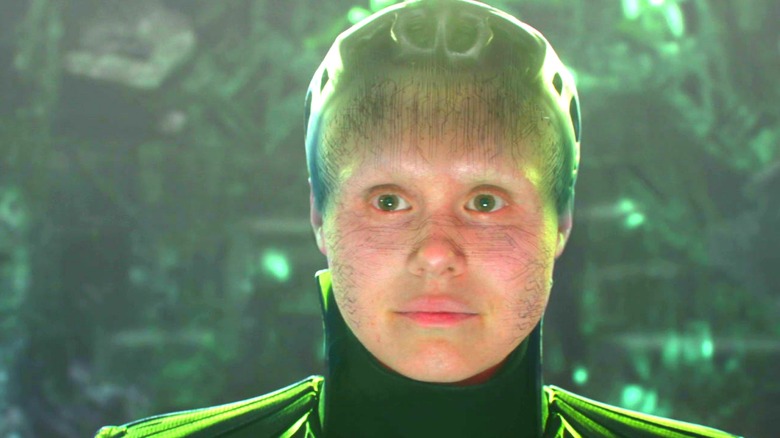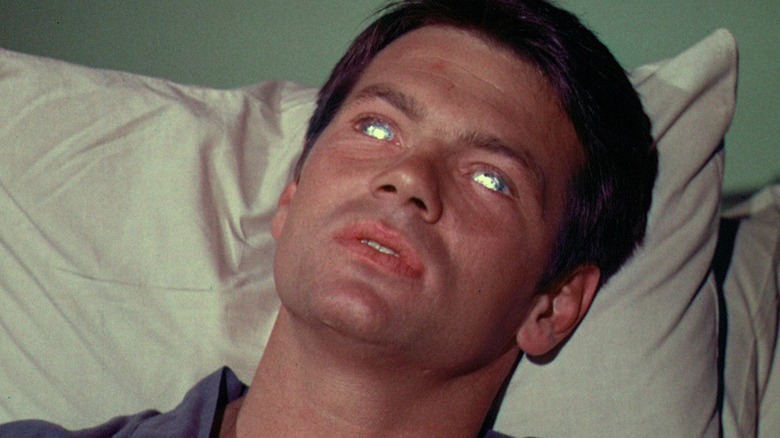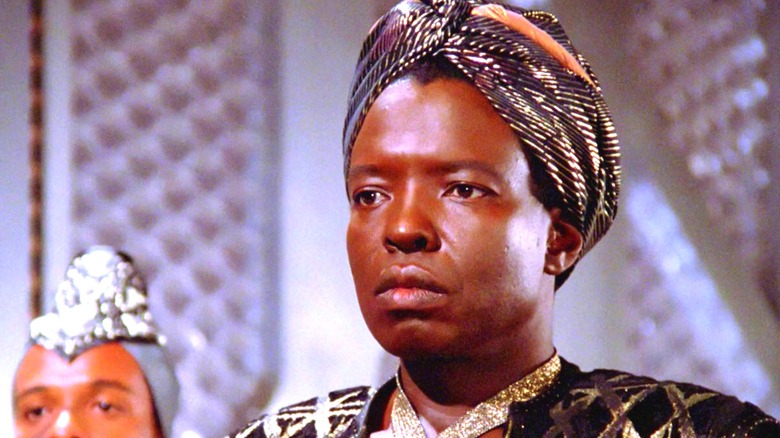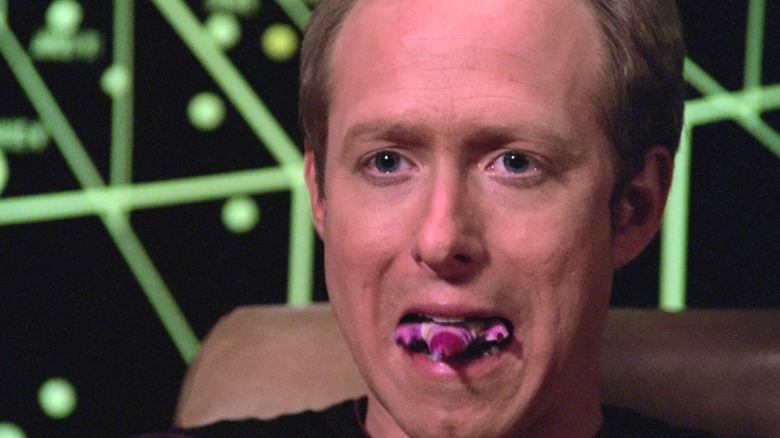10 Iconic Star Trek Villains That Are Actually Overrated
From "Star Trek: The Original Series" to the recent introduction of Paramount Trek shows like "Star Trek: Discovery" and "Strange New Worlds," the ever-expanding Trek franchise has no shortage of great — or at the very least, memorable — villains. Some of the best villains in the Trek franchise are conniving and duplicitous in nature like Kai Winn (Louise Fletcher) or fan favorite Gul Dukat (Mark Alaimo) of "Star Trek: Deep Space Nine." And then there are the absolutely unhinged villains of the Trek universe like the "Lower Decks" baddies Badgey (Jack McBrayer) and Peanut Hamper (Kether Donohue).
But for every "Star Trek" villain that hits hard, there are a dozen of the middling and "meh" variety — like that weird collector (Saul Rubinek) who kidnapped Data (Brent Spiner) in the "Star Trek: The Next Generation" episode "The Most Toys," or that woman (Marta DuBois) who cosplays as the devil in another "TNG" episode, "Devil's Due." Because not every antagonist can be as fierce as they want us to think they are, here are ten of the most iconic Trek villains who put off more beet juice than blood wine energy.
The Post-Ricardo Montalbán Khan
The fact that Khan Noonien Singh is one of the meatier villain roles in the "Star Trek" universe makes it all the more frustrating that not even a Shakespearean actor like Benedict Cumberbatch could rekindle the magic. Originally showing up for a memorable appearance in the "Star Trek: The Original Series" episode "The Space Seed" in 1967, Ricardo Montalbán would go on to become one of the most iconic villains in the Trek universe — a status sealed his sinister reprisal 15 years later in "Star Trek 2: The Wrath of Khan."
A genetically superior ruler expelled from Earth during the Eugenics Wars, Khan awakens from cryo-sleep only to take over the Enterprise and get abandoned on Ceti Alpha V. Despite his initial fears about sounding too much like Mr. Rourke after having taken on the role at the end of a years-long stint on "Fantasy Island," Montalbán absolutely killed it after rewatching Khan's old episode on repeat a few times. "What I have to do now is bring that character and make it passionate because he's blaming Kirk for the death of his wife," Montalbán said in a 2002 Television Academy interview. Many fans would come to see the villain as Trek's top foe and the performance as the finest of Montalbán's career. While Cumberbatch's Khan in the Kelvin timeline film "Star Trek: Into Darkness" was objectively good, many fans felt it simply wasn't the same villain as Montalbán's Khan.
Shinzon, the Unnecessary Clone
Tom Hardy was still at the beginning of his career when he took on the role of Shinzon, the disappointing Jean-Luc Picard (Patrick Stewart) clone in "Star Trek: Nemesis." This movie is typically rated by "TNG" fans as the worst in the "Next Generation" film canon. On its face, the concept feels a bit like a long episode were it not for two major life transitions at the front and back end of the film. The Romulans were up to their old shenanigans, trolling the humans with clones, when they decided to scrap a Picard clone project and abandon the child Shinzon in the Reman slave mines. Some time later, Shinzon has grown up to lead the Remans and terrorize the Romulans. Worse, he's mad at the world and wants to make it Picard's problem that he's dying of a genetic blood disorder.
But aside from his pretty sweet Space Balenciaga aesthetic and a solidly intense portrayal from Hardy, Shinzon felt gratuitous to many viewers. Fans found the young Shinzon's bald head perplexing, particularly given the hair already shown on a young Picard in "Star Trek: The Next Generation." Many felt the directors simply thought fans wouldn't find a lush-locked Picard clone believable. Shinzon's being a clone also adds little to the story. If he was meant as a Picard foil to show the captain's darker side, the effort failed. And it's hard to buy that a guy who rose so far would waste that on a personal vendetta.
The Suliban
As a general concept, the Suliban Cabal — the main antagonists toward the beginning of "Star Trek: Enterprise" — were pretty solid villains. With their people strewn across the galaxy after a diaspora in the wake of their home planet becoming uninhabitable, the Suliban race faced a power vacuum. And like all good political power vacuums, it had to be filled with the worst possible representatives of the community in the form of the Suliban Cabal, a faction of Suliban given special genetic alterations as payment for their role in the Temporal Cold War.
The Suliban Cabal's genetic alterations could get pretty freaky — we're talking bendy bones and chameleon flesh freaky. They were skeezy, unsettling, and generally creeps who seemed to only want one thing: to artificially upgrade their evolution on a case-by-case basis commensurate with each individual's contribution to their terrorism. And the fact that they were being urged on a by a mysterious Zoom caller from the future only made them creepier.
Sadly, they only became less so over the course of the series, and the fact that they don't show up later in the Trek universe is always hanging in the air throughout "Enterprise." Writing on his blog Eavesdropping With Johnny in 2009, "Enterprise" production illustrator John Eaves mused, "The Suliban were a strange race and they were to be so prominent in the new series, but by season 2 they had pretty much faded away." As to what, exactly, became of them? Only the giant space koala knows.
John de Lancie's Q
Originally introduced as a villain in the first episode of "Star Trek: The Next Generation," Q (John de Lancie) quickly became one of the most beloved antagonists in the world of Trek. A quasi-omnipotent extradimensional being with a penchant for cosplay from a race of similarly overpowered beings who share his name, Q first set out to test humanity but quickly became fixated on Jean-Luc Picard. But despite his potential for causing mayhem, Q eventually turns out to be kind of a marshmallow, often serving to advise or nudge his human favorites as a sort of benevolent trickster.
That's not to say Trek fans don't all love Q and enjoy every moment of his scene-eating performances. But by the middle of "Star Trek: Picard," he's far from anything that could be considered a villain, eventually serving more as a deus ex machina for the Terry Matalas-sized time-travel web the audience finds themselves wrapped up in at the end of "Picard" Season 3. As one frustrated Reddit user lamented, "Dude was like the god mode cheat of story arcs. Super lazy way to round off any predicament... I honestly don't know how they made a fourth dimensional omniscient character so frigging boring."
The post-queen Borg
There's plenty to find frightening about the Borg, the race of cybernetic organisms that assimilate anyone they feel is worthwhile into their hive mind. It's the ultimate space cult — once you're in it, you don't even care because that's exactly where you want to be. Never mind that you're trading in sexy holodeck time, replicator coffee, and Dancing Doctor performances for sleeping in a closet outfitted with a suped-up phone charger.
But as tends to be the case in the "Star Trek" universe, the writers did everything they could to squishify the Borg as the franchise progressed. They gave us a singing ex-Borg, Borg kids, and Borg babies. Heck, they even gave us a friendly Borg queen in "Star Trek: Picard" (Alison Pill).
But many fans say it's not the cute kids and Picard pal boss that defang these iconic "Star Trek" villains — it's the fact that the franchise ever chose to give the Borg a boss at all. In their view, what made the Borg so absolutely terrifying as villains was the existential threat they represented, one in which you could lose your identity altogether along with any sense of connection to anyone you ever loved. Before the queen, they were basically mindlessly riding on autopilot, collectively carrying out their mission to assimilate everyone. From the moment they added a queen to the mix, the Borg started to lose their fear factor until they eventually devolved into just another defeatable foe.
Gary Mitchell
If you're a latecomer to the "Star Trek" series and you either haven't had a chance to fully catch up on your "TOS" watchlist or you just don't have the stomach for 1960s special effects, you could be forgiven for not knowing who Gary Mitchell (Gary Lockwood) is. But Mitchell is often regarded as one of the more frightening villains in "The Original Series," in part because of his connection to one Captain James T. Kirk (William Shatner), and in part because of his appearance as the first villain in Kirk-era "Trek" if you're going by production order ("Where No Man Has Gone Before"). And that's to say nothing of the freaky tinfoil scleral contact lenses Lockwood had to wear while playing him or his eerie line, "Morals are for men, not gods."
Before leaving the Milky Way galaxy, Lieutenant Commander Mitchell appears to be a fairly run-of-the-mill Starfleet dudebro, right down to his unwanted harassment of the ship's new psychiatrist Dr. Elizabeth Dehner (Sally Kellerman). But things go sideways when the ship crosses some weird barrier that kills nine crewmen and supercharges the ship's two ESPers, who happen to be Dehner and Mitchell.
Turned on, tuned in, and ready to drop the heck out, Mitchell suddenly finds himself with telekinesis, telepathy, and a seriously high IQ. And he wastes no time demonstrating that he's the worst kind of person to have godlike powers. But at the end of the day, his terrible personality — one that once tried to knock Kirk out of Starfleet Academy — makes him more overpowered space creep than villain.
The Crystalline Entity
So much of the "Star Trek" universe is populated with humanoids that Riker would be glad to hook up with that it's almost refreshing to run into a giant space jellyfish, or some other weird entity, from time to time. And that's certainly true when we learn Data's identical twin and brother-of-the-year, Lore (Brent Spiner), has been hanging around with a bad crowd in the form of the Crystalline Entity, the giant space snowflake with a hankering for whole civilization-sized snacks. But for a predator so nebulous — it has the ability to block out the sun like a massive broccoli-shaped cloud — the entity seems to function more like a dumb wild animal than a sentient, malevolent being.
Think about it: the entity needs Lore to tell it where those planet-sized snacks are in "Datalore" and "Silicon Avatar." Without him, it's just a derpy old space snowflake bumbling around the cosmos like a beagle sniffing around under the dinner table in search of a crumb. Heck, it might not even be a compulsory carnivore but rather an opportunistic one. This seems to be backed up by the second crystalline entity encountered in the "Star Trek: Lower Decks" episode "I, Excretus" that the Cerritos crew finds noshing on nebula radiation. At this point, why not just section off a space wildlife reserve and get some self-appointed do-gooders like the Vulcans to pony up for a steady supply of nebula juice... crisis averted.
Lutan from Code of Honor
The fact that no self-respecting "Star Trek" fan wants to look too closely at the reality that the "Star Trek: The Next Generation" episode "Code of Honor" happened doesn't mean it didn't. But if we can look past the cringeworthy racial stereotyping and the gratuitous use of lamé in a "Star Trek" episode Jonathan Frakes has openly called "embarrassing," we'll find a villain so overrated (and underpowered) that he causes Picard to completely fumble the whole situation.
The gentleman in question is the infamous Lutan (Jessie Lawrence Ferguson), the leader of the Ligonian people. Bossy, arrogant, and hot for Tasha Yar (Denise Crosby), Lutan gets the bright idea to kidnap the ship's chief of security and hold a much-needed vaccine hostage. By the end of the episode, he's inadvertently gambled away all he has, losing everything when Yareena (Karole Selmon), the wife from whom his authority derives, temporarily dies, thus dissolving their marriage contract.
As he's standing there all egg-face, there's a general sense that this man got his just desserts as a guy who chose to risk his First One and his people's diplomacy with the Federation. But at the end of the day, he wasn't even really a villain at all; he was just acting according to his culture's norms. The true villain in this story is the person charged with preparing the Starfleet briefing materials for their diplomatic encounter and didn't give anyone a head's up that showing up with a sassy security officer was a bad idea with these folks.
The Bluegill parasites that took over Starfleet
"Star Trek: The Next Generation" had its own version of that conspiracy theory where reptilians take over world leaders and celebrities when the Bluegills infiltrated Starfleet's upper ranks, demonstrating that not every symbiotic race can be as chill as the Trill. Once inside their human hosts, these little parasitic creeps dig their way into their victims' brain stems. By tapping into their host body's adrenal glands to give them a hormonal supercharge, the Bluegills supe up their victims into 'roided out meat suits, making them harder to tank.
It's true that the whole conspiracy nature of the Bluegills' Starfleet Command doings make them a formidable foe. But if you look just a little bit closer, it's almost hard to understand how they made it as far as they did in the admiralty. By the time they've infiltrated the upper ranks in "Conspiracy," Starfleet HQ is positively abuzz with conspiracy rumors. And we know they're neither stealthy or discreet by the absolute botch job that the artist, formerly known as Real Admiral Gregory Quinn (Ward Costello), makes of his attempt to infect Riker aboard the Enterprise. They might be fast, but not so fast someone with a phaser or a decent pair of regulation boots could not take them out. Worse, they follow vampire rules, meaning if you kill the queen parasite, the rest of them die — which is just patently ridiculous, not to mention one heck of a vulnerability.
The Kazon
If there's one antagonist race that just about every "Star Trek" fan finds underwhelming, it's the "Star Trek: Voyager" villains, the Kazon. They're not just a cornier, big-haired take on the Klingons — they're more like the Temu knock-off version right down to their less impressive facial ridges and watered-down warrior ethos, making the fact that they get so much airtime in the first two seasons of "Voyager" almost intolerable.
Freshly stranded in the Delta quadrant, the Voyager crew first encounters the Kazon in the "VOY" premiere episode "The Caretaker," where they show up as oppressors of the even more ridiculous Ocampa (just try to do the math on how long a species that can only have one child per female survives). But they're more like 19th century Birmingham street gangs than actual warriors, and they serve as more of a nuisance to Captain Janeway (Kate Mulgrew) and her crew than any kind of credible threat. Misogynistic, disorganized, and none too bright, the Kazon were about as toothless as a "Star Trek" villain comes. As one fan wrote on The Trek BBS, "To call them cavemen is an insult to cavemen." A foe so unworthy was never truly a match for Janeway — at least, not after coffee.
